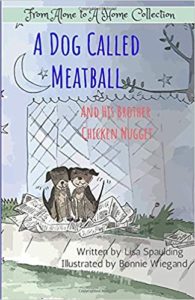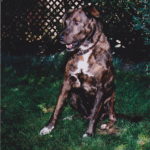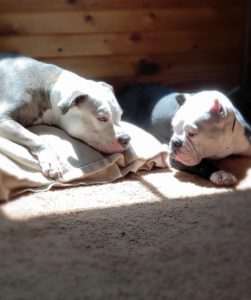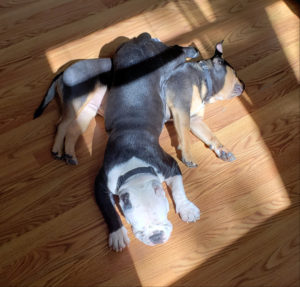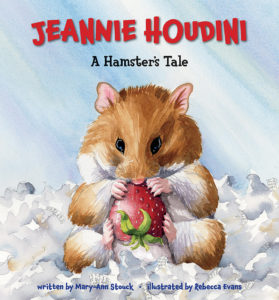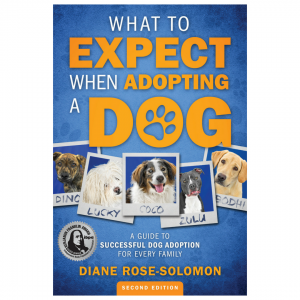To read Diane’s most recent blog posts, please see the Behind the Scenes blog at AnimalagicFilms.com.
*
My trip to India was, as they say, life-changing. I was there because my graduate school program required that I volunteer in a developing country for two weeks. I had never been to India and had always been curious, plus I practice yoga, meditate, love Indian food and the timing seemed right.
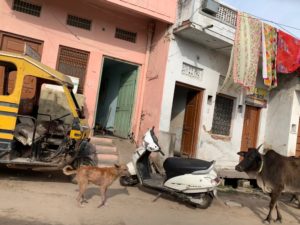
Street animals
Prior to the trip I wrote two papers about India. One, a general cultural paper, and the other more specifically about the street dog population issues. Each helped me to understand a lot of what I would encounter, yet no amount of research can substitute for direct experience.
I was traveling as a student and was counseled to always approach a different culture as a learner. It’s good counsel. I did my very best to be as open-minded as possible, though there are always biases. I acknowledge that the following views stem from my very Western values and experiences.
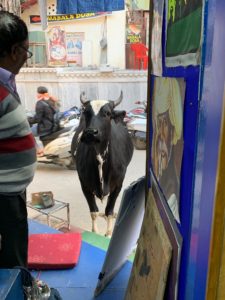
Daily visit from a hungry cow
One of the things I learned during my research was about the difference between Eastern and Western philosophy regarding where dogs live. In India, dogs that roam free are not considered stray. They are street dogs. It’s not that they don’t have a place to live- it’s just that they live outside. Part of Indian culture includes a connection between all things, animate and inanimate. Thus, dogs, and other animals, wherever they live, are part of the environment, the fabric of Indian culture.
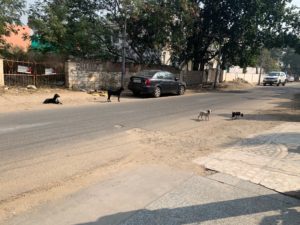
Puppies crossing the street
Some of the 25 million dogs in India are cared for by a family or the community though they come and go as they please. Others are just fending for themselves. You have likely seen images of street dogs in developing nations, or even in India. Some of them look very healthy and well cared for, while others are emaciated, sick or injured. Plus, a big part of Indian culture is the number of vehicles on the road. They drive fast and the rules… well, it’s kind of a free-for-all, so there are a lot of animals struck by vehicles.
In the US, and many developed Western countries, dogs (and other animals for that matter), don’t live in the streets. If they are there, there’s usually something wrong- such as someone cast them out or left them behind. Thus, we created a shelter system where dogs (and cats and sometimes other animals) can be cared for until they find a home. Except that since we created this system, millions of healthy adoptable pets have been euthanized because there isn’t enough space for all the animals in the shelter. Granted, the number of animals entering the US shelters has dropped dramatically since the 1970s but it’s still considered acceptable that we are killing healthy animals in this culture. Another reminder for people not to judge others (because our system is flawed too).
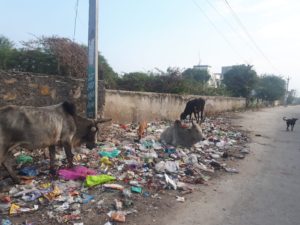
Garbage is a food supply
I had numerous conversations with both Westerners and Indian people in India about this topic. Some people are in favor of the free-roaming dogs because at least they aren’t at home all day bored like western dogs are, while the owners are at work. Street dogs get to come and go as they please and they have “friends” and stimulation. There is merit here.
The fact that many street animals (barely) survive by eating garbage is not ideal (that’s a whole different topic), and there is minimal veterinary care, if any, for most street dogs. Yet, there is a little slice of heaven in Udaipur, India called Animal Aid Unlimited (AAU), where I volunteered. The dogs that are sick or injured arrive at Animal Aid get fixed up as best as they can, and then they go back to the streets where they came from. In cases such as having been paralyzed by getting struck, or otherwise incapable of fending for themselves, dogs will have a permanent home at AAU.
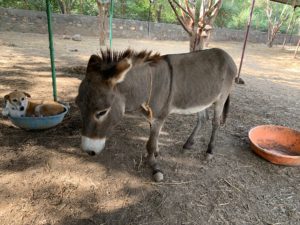
Tony the donkey

Calf feeding time
AAU also cares for other animals such as cows, bison sheep, goats, chickens, orphaned calves, and donkeys whose owners have overworked them causing them physical damage rendering them useless as a working animal.
I need to acknowledge their incredible work. The organization is professionally run, they welcome volunteers and have done as much as possible to ensure everyone’s safety and enjoyment while there.
The love that they give and show to the animals is amazing. And what is happening systemically is that people now see the AAU ambulances around town and know whom to call when they see an injured or ill dog. The ambulances have their phone number emblazoned on the side of the truck. AAU receives 60-70 emergency calls daily.
In the past, sick and injured dogs languished in the streets. But people are now paying attention to the ones in distress and they have a place to call. Not only does this impact that person, but then other people in the neighborhood witness this, and are now touched by the act. Check out the video on AAU’s home page to learn more about how this is transforming the city.
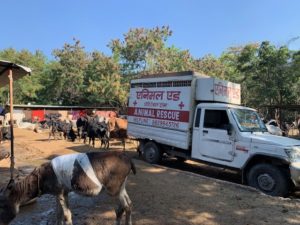
Animal Aid Ambulance

First aid program graduates
While it will take time, I suspect that AAU’s impact will grow throughout India. It already has. Since there are so few veterinarians in India, AAU offers a comprehensive first aid training to people who are willing to spend a week at AAU. They then take their new skills back to their village and help animals in need. It is truly inspiring.
A major concern, however, is that there are only 50 animal shelters in India (as compared with about 13000 shelters and rescue groups in the US) so there is insufficient care for the animals. As soon as I left Udaipur to travel around India, I was distressed that I wouldn’t know where to call when I saw a suffering animal. This brings us back to the original idea that many animals in India are not cared for, are scrounging for food, are injured or sick. 90% of the puppies born do not survive…and there are a lot of puppies.
The paper I wrote discussed the challenges of decreasing the street dog population via sterilization for many logistical reasons in India. Yet, it is heartbreaking that more and more animals appear on the streets every day that will become sick, injured or killed. AAU does an amazing job caring for as many animals as they can in Udaipur, and they are just one organization. Wouldn’t it be cool if there weren’t quite so many animals to have to care for?
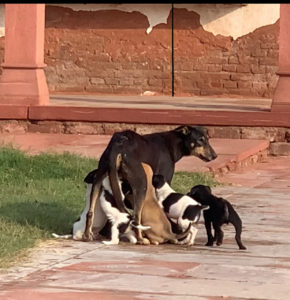
More puppies
Another consideration is whether Indian culture accepts dogs as pets. Yes, poverty is an issue. Yet there is a larger middle class than in the past and some of these people are buying dogs from breeders. The obvious question is: Why aren’t they just adopting the street dogs? Well, there are a few answers. First, they are not considered the “same.” (Street dogs belong in the street, but the dog that I have in my house should be purebred).

Clean and healthy dog being walked on a leash
Second, some of the street dogs are feral and wouldn’t make good pets- they are used to outdoor life and living in a pack. I get that.
Third, I’m not sure that the culture universally embraces animals living indoors. I wonder if an “Adopt, Don’t Shop” campaign, like we have in the US, could make a difference there. Maybe someday.
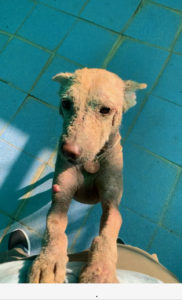
Sweet dog with his paws on my legs
Here’s what bothers me. I spent almost two weeks at AAU and a day at another shelter/hospital called Arunachala in a town called Tiruvannamalai. Granted, some of the dogs I met were not interested in being cuddled or petted but many of them were. It’s not as if they are all wild feral dogs that could not possibly have an easier existence if they had regular healthy meals, veterinary care, and a soft bed to sleep on. I believe there’s a better way.
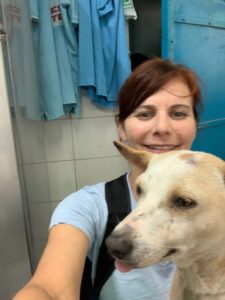
Selfie with a buddy who jumped on my lap
Having said all this, remember that I have acknowledged that western culture isn’t perfect either. I wonder if there isn’t a new model that combines the best of both. Dogs out of harm’s way, with proper food, veterinary care, a warm bed, and someone to love them would be great. Let’s assume that the new model didn’t include a home for each dog, but they continued to live in a community. Perhaps more doggie daycares, or sanctuaries or some kind of community model could satisfy these issues.
It is truly impossible to attempt to solve these challenges in India (or in the US for that matter) in one post and I know I am opening a big can of worms. I am aware that there are innumerable people in India and around the world making a difference to these animals, and I bow to your commitment and efforts. I know that it takes money, human-power and a massive coordinated effort to accomplish anything this grand. I simply wanted to share my observations, particularly that I believe these dogs deserve to have more love, attention, and care than what they have now.
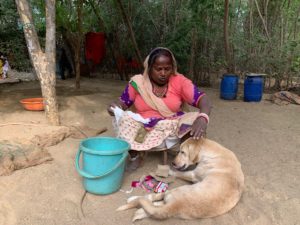
Care from the employees at AAU
Before I close, I want to be clear that I loved my time in India. There’s a beauty in the chaos that is indescribable and incredible natural riches. Most of the people I met were kind and caring and made me feel welcome, and of course, I fell in love with the animals. I hope to return someday. If you would like to see my photo journey, please check it out on Instagram @dianersolomon (it’s easiest to see there).
When I do return to India, I hope to volunteer at Animal Aid again. If you are moved to volunteer there, I highly recommend it. Let me know and I’ll give you information about where I stayed and how I got there.
All of the organizations in India can use your support. These are the two that I spent time at and will continue to support:
Animal Aid: https://animalaidunlimited.org/
Arunachala: http://www.arunachalasanctuary.com/index.php
(My friend’s dad started Arunachala in 2007. It is much smaller than AAU but they are doing an amazing job in Tiru and can use continued funds.)
Meanwhile, we still have plenty of animals in the US that need homes, so please Adopt, Don’t Shop. Lives are depending on you. And if you’d like to make a difference in the US via donation, these are a couple of my favorites:
https://www.deitydogsandgoods.com/dogs
https://startrescue.org/
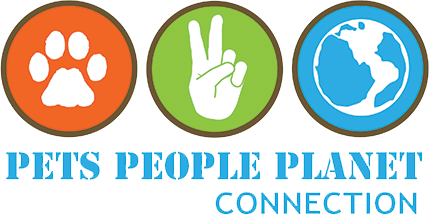


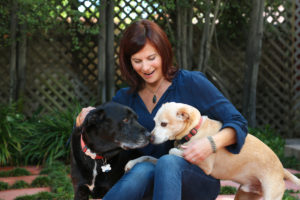
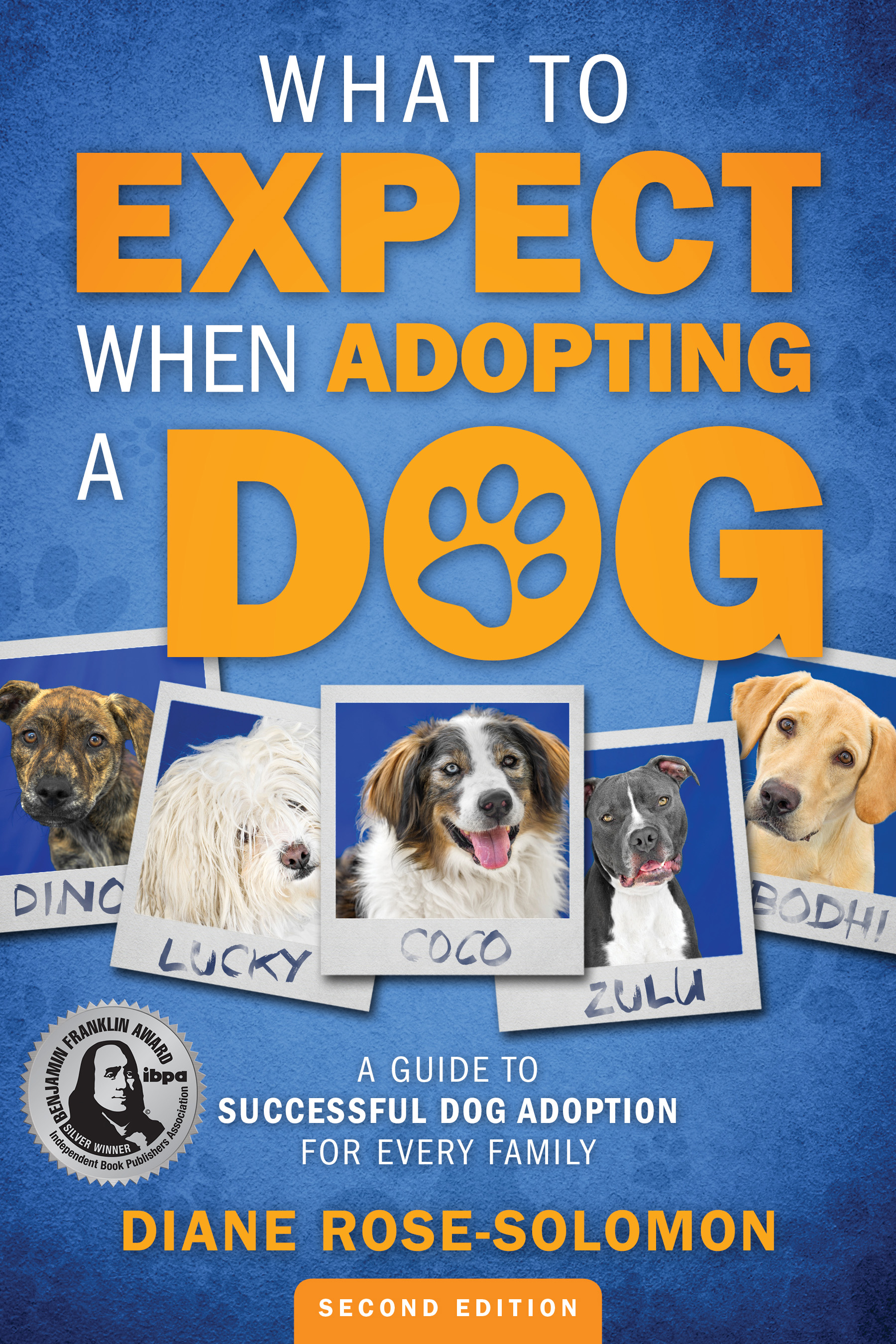
 pressed her general vet to investigate Leptospirosis.
pressed her general vet to investigate Leptospirosis.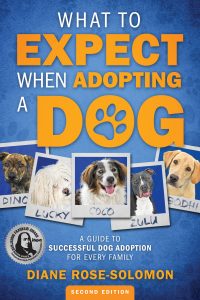

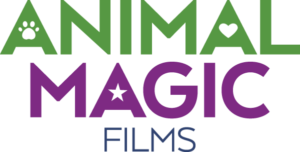
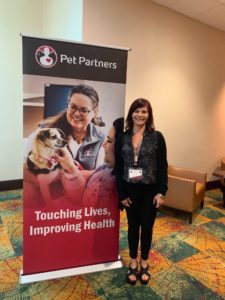 Over the next few months I will continue sharing what I’m learning and then we’ll see where this all takes us. It’s going to be a mixed bag as we settle in. I anticipate some modifications in format, but I’m taking one step at a time. The new website will be up in a few weeks and will be interactive and informative. Animal rescue will always be near and dear to my heart and the Human-Animal Bond work will ideally serve to bolster it and help more people and animals worldwide. I am so grateful that you are here on this amazing adventure with me.
Over the next few months I will continue sharing what I’m learning and then we’ll see where this all takes us. It’s going to be a mixed bag as we settle in. I anticipate some modifications in format, but I’m taking one step at a time. The new website will be up in a few weeks and will be interactive and informative. Animal rescue will always be near and dear to my heart and the Human-Animal Bond work will ideally serve to bolster it and help more people and animals worldwide. I am so grateful that you are here on this amazing adventure with me.